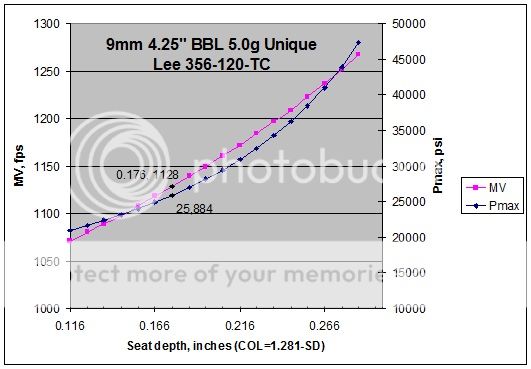LiveLife
Member
Does loading longer reduce gas leakage and produce greater accuracy?
I have seen both sides of this question where 40S&W 180 gr bullets loaded longer than SAAMI max of 1.135" to 1.142" with MBC lead/Berry's plated TCFP and 1.155" with RMR HCM RNFP produced greater accuracy while 9mm 115 gr FMJ/RN bullets produced greater accuracy at shorter 1.130" - https://www.thehighroad.org/index.p...ick-plated-bullets.761471/page-4#post-9645513
While continuing load development and range testing with IMR's new Red, Target and Green powders along with Vectan Ba 9.5 and Ba 9 powders, I wanted to start verifying accuracy difference between long vs short OAL/COL.
Since 4.2-4.3 gr of IMR Target produced smaller groups with RMR 115 gr FMJ/HCM RN and 124 gr HCM RN bullets, same powder charge was used to load following test rounds - https://www.thehighroad.org/index.p...-and-vectan-ba-9-5-ba-9.817796/#post-10508215
- RMR 115 gr FMJ at 1.130"
- RMR 115 gr FMJ at 1.155"
Sorry for the wet target pictures but it was a rainy windy range day and plastic sheet over the target paper did not do much to keep the paper dry. Comparison shot groups should give us a good starting point for this myth busting thread.
17" Just Right carbine was used with Bushnell 6-18x50mm scope and shot from inside the suburban (my rain shelter) using UTG bipod at 25 yards for 10 round shot groups.
RMR 115 gr FMJ with 4.2-4.3 gr IMR Target at 1.130" OAL (Left) and 1.155" OAL (Right)

Same 1.130" shot group with different 1.155" shot group

I have seen both sides of this question where 40S&W 180 gr bullets loaded longer than SAAMI max of 1.135" to 1.142" with MBC lead/Berry's plated TCFP and 1.155" with RMR HCM RNFP produced greater accuracy while 9mm 115 gr FMJ/RN bullets produced greater accuracy at shorter 1.130" - https://www.thehighroad.org/index.p...ick-plated-bullets.761471/page-4#post-9645513
While continuing load development and range testing with IMR's new Red, Target and Green powders along with Vectan Ba 9.5 and Ba 9 powders, I wanted to start verifying accuracy difference between long vs short OAL/COL.
Since 4.2-4.3 gr of IMR Target produced smaller groups with RMR 115 gr FMJ/HCM RN and 124 gr HCM RN bullets, same powder charge was used to load following test rounds - https://www.thehighroad.org/index.p...-and-vectan-ba-9-5-ba-9.817796/#post-10508215
- RMR 115 gr FMJ at 1.130"
- RMR 115 gr FMJ at 1.155"
Sorry for the wet target pictures but it was a rainy windy range day and plastic sheet over the target paper did not do much to keep the paper dry. Comparison shot groups should give us a good starting point for this myth busting thread.
17" Just Right carbine was used with Bushnell 6-18x50mm scope and shot from inside the suburban (my rain shelter) using UTG bipod at 25 yards for 10 round shot groups.
RMR 115 gr FMJ with 4.2-4.3 gr IMR Target at 1.130" OAL (Left) and 1.155" OAL (Right)
Same 1.130" shot group with different 1.155" shot group







